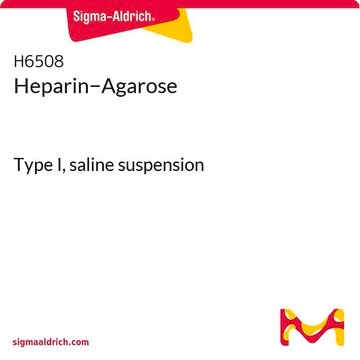The base bead for H0402 is Sepharose beads at 45-165 µm in diameter, while the base for H6508 is a 4% Agarose Bead at 50-150 µm. It is important to note that the bead size is not measured after affinity ligand attachment.
H0402
Heparin−Agarose
(1:1 suspension in a 20% ethanol solution)
Seleccione un Tamaño
US$ 372,00
Fecha estimada de envío13 de mayo de 2025
Seleccione un Tamaño
About This Item
US$ 372,00
Fecha estimada de envío13 de mayo de 2025
Productos recomendados
origen biológico
heparin from Porcine intestinal mucosa
Nivel de calidad
Formulario
(1:1 suspension in a 20% ethanol solution)
Matriz
4% beaded agarose
activación de la matriz
epichlorohydrin
unión a la matriz
terminal aldehyde by reductive amination to amine linker
espaciador de matriz
7 atoms
capacidad
≥0.5 mg/mL binding capacity (thrombin)
temp. de almacenamiento
2-8°C
¿Está buscando productos similares? Visita Guía de comparación de productos
Aplicación
Forma física
Nota de preparación
Palabra de señalización
Warning
Frases de peligro
Consejos de prudencia
Clasificaciones de peligro
Flam. Liq. 3
Código de clase de almacenamiento
3 - Flammable liquids
Clase de riesgo para el agua (WGK)
WGK 3
Punto de inflamabilidad (°F)
104.0 °F - closed cup
Punto de inflamabilidad (°C)
40 °C - closed cup
Elija entre una de las versiones más recientes:
Certificados de análisis (COA)
¿No ve la versión correcta?
Si necesita una versión concreta, puede buscar un certificado específico por el número de lote.
¿Ya tiene este producto?
Encuentre la documentación para los productos que ha comprado recientemente en la Biblioteca de documentos.
Los clientes también vieron
-
What is the size of the agarose beads?
1 answer-
Helpful?
-
Active Filters
Nuestro equipo de científicos tiene experiencia en todas las áreas de investigación: Ciencias de la vida, Ciencia de los materiales, Síntesis química, Cromatografía, Analítica y muchas otras.
Póngase en contacto con el Servicio técnico








